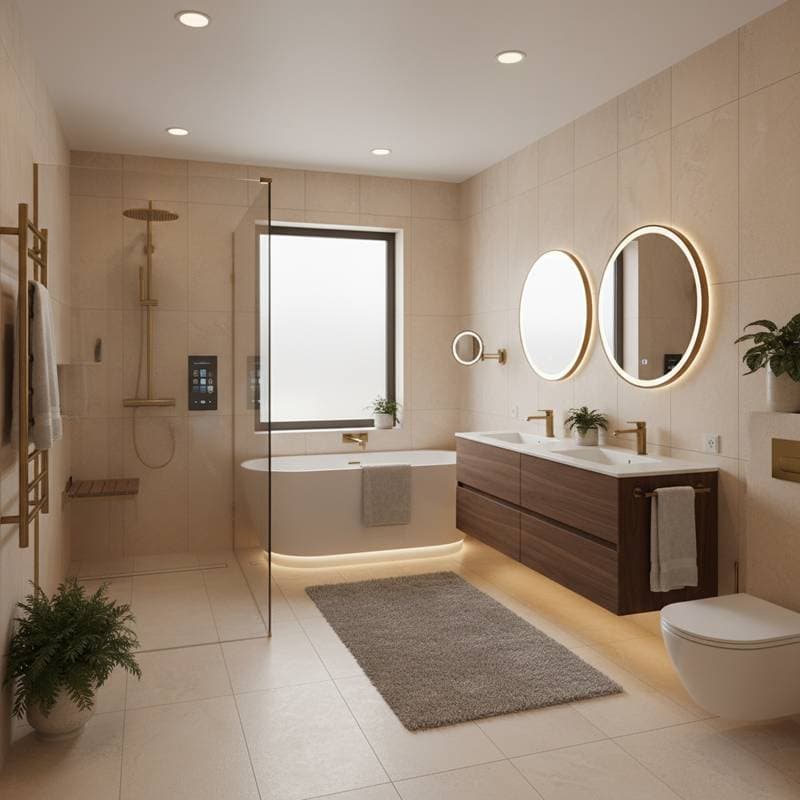Bathroom Designs That Enable Aging in Place for 2025
Bathrooms can support independence or pose daily risks as individuals age. Standard designs often overlook accessibility, making this room the most hazardous in the home. Slippery surfaces, narrow doorways, and inadequate lighting transform routine tasks into challenges. Thoughtful design addresses these issues, promoting comfort and safety for long-term use.
Why Typical Bathrooms Fail Older Adults
Standard bathrooms suit young, agile users with features like narrow doors, low toilets, and high tub edges. These elements create barriers as balance, strength, and flexibility decline. Falls occur frequently, leading to serious injuries that demand costly emergency modifications.
Aging-in-place design adapts the environment to evolving needs rather than requiring users to adjust. Focus on removing obstacles, enhancing stability, and prioritizing safety while preserving aesthetic appeal. Such approaches ensure the space remains inviting and effective over time.
1. Establish an Optimal Layout
Layout forms the foundation of safety and functionality. Ensure at least five feet of turning radius for wheelchairs or walkers. Doorways require a minimum width of thirty-two inches; opt for thirty-six inches where possible to facilitate movement.
Eliminate sharp corners and confined turns. Consider pocket doors or barn-style sliders for bathrooms adjacent to bedrooms to conserve space and avoid navigating swinging doors. Position the toilet and shower on opposite walls to create ample open floor area and streamline access.
2. Select a Zero-Threshold Shower
High curbs and step-in tubs contribute to many falls. A zero-threshold shower provides a smooth floor transition from the main area, eliminating these risks. This design appears contemporary and seamless, avoiding a clinical appearance.
Effective drainage prevents water accumulation; install linear drains along a wall or at the entry point. Choose non-slip tiles with matte finishes for reliable traction in wet conditions. Incorporate a built-in bench and a handheld showerhead on a vertical slide bar to accommodate seated or standing positions, benefiting users of all ages.
3. Incorporate Grab Bars from the Start
Homeowners often view grab bars as utilitarian and unappealing. Modern versions integrate seamlessly, available in finishes that coordinate with faucets and hardware, serving as stylish elements.
Reinforce walls with solid backing during initial construction to allow future grab bar installation without damaging finishes. Place bars strategically near the toilet, within the shower, and at the entrance. This preparation avoids disruptive and expensive retrofits later.
4. Select a Comfort-Height Toilet
Standard toilet heights prove challenging for those with reduced mobility. Comfort-height models raise the seat by two to three inches, easing the process of sitting and standing. Advanced options feature built-in bidet functions, heated seats, and subtle night lighting.
Install nearby outlets to power these enhancements for long-term planning. Add grab bars on both sides or a supportive frame attached to the base for added security. Verify that mounting surfaces withstand weight and dynamic forces prior to finalizing the setup.
5. Enhance Lighting and Visibility
Inadequate lighting conceals potential dangers, while glare from reflective surfaces disorients users. Implement layered illumination: overhead fixtures for general brightness, targeted mirror lights for tasks, and low-level night lights for orientation.
Motion-activated sensors simplify nighttime activation without searching for switches. Select warm white light bulbs to improve depth perception and foster a welcoming atmosphere. Steer clear of cool-toned lights that render the space harsh and impersonal; clear visibility directly enhances safety.
6. Choose Stability-Supporting Materials
Elegant smooth marble risks slips when wet. Opt for textured porcelain or traction-engineered vinyl flooring. Matte finishes on countertops and tiles minimize glare, aiding those with visual impairments.
Thermostatic shower valves maintain consistent temperatures to avoid scalding incidents. Lever-style handles prove simpler for users with arthritis or weakened grips compared to twist knobs. All selections must balance safety, usability, and harmonious design.
7. Build in Future Adaptations
Aging-in-place principles emphasize versatility over rigid medical aesthetics. Reinforce walls to support additional grab bars or foldable benches as requirements evolve. Design wide entryways to accommodate mobility aids without constraint.
Size showers generously to allow space for chairs if needed. During the planning phase, anticipate changes over the next ten years. Initial investments in adaptability often offset substantial future expenses.
8. Balance Safety and Aesthetic Appeal
Accessible bathrooms need not appear institutional. Employ contrasting colors to delineate surfaces and edges, assisting those with diminished vision; for instance, pair a dark vanity with light walls to enhance spatial awareness.
Warm metal finishes like brushed nickel or bronze impart timeless comfort. Replace deep cabinets with open shelving and reachable drawers to reduce bending and stretching. Install forward-tilting mirrors to facilitate grooming from seated positions. Each choice advances both practicality and enjoyment.
Steps to Implement Your Design
Realizing an aging-in-place bathroom demands strategic planning beyond basic construction. Engage a contractor experienced in universal design. Inquire about past accessibility projects, obtain references, and confirm credentials including licensing and insurance.
Discuss adherence to standards such as grab bar positioning and unobstructed floor areas. This collaboration yields a space that safeguards independence, minimizes risks, and elevates daily living with enduring style and efficiency.










